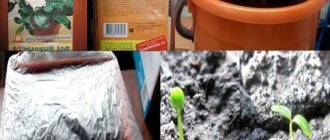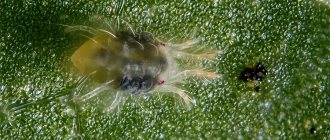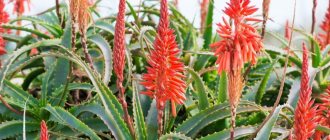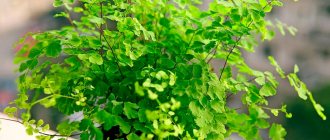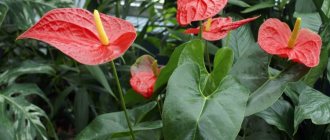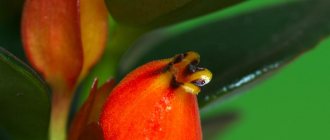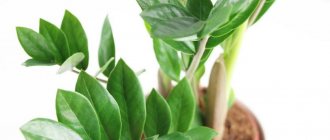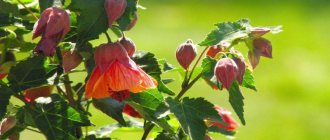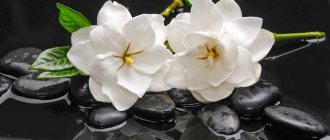Author: Elena N. https://floristics.info/ru/index.php?option=com_contact&view=contact&id=19 Category: Garden plants Published: January 27, 2019Last edits: November 03, 2020
- Growing conditions
- Reproduction methods
- Preparation
- Western thuja (Thuja occidentalis)
plant (lat. Thuja) , or life tree , belongs to the genus of gymnosperm coniferous plants of the Cypress family, like juniper, sequoia, taxodium, cypress and cypress. Thuja was brought to Europe from East Asia or America. The Latin name of the plant has an ancient Greek root meaning “sacrifice”, “incense” - apparently, there is a connection between the name of the plant and the smell of aromatic thuja species ritually burned as incense. The genus includes 6 species, representatives of which sometimes live up to 150 years, although much more mature specimens are also found. In addition to some species, about 120 varieties of plants are grown in culture, differing in the color and quality of the needles and the shape of the crown. Thuja in landscape design is one of the basic plants and is grown as a tapeworm or in a group, and is also used to design alleys, borders, and create hedges.
Planting and caring for thuja
- Planting: possible in the fall, but it is more reliable in the spring.
- Flowering: the plant is grown as an ornamental foliage plant.
- Lighting: bright light in the morning and partial shade in the afternoon.
- Soil: nutritious, sandy loam or loamy.
- Watering: sprinkling method. Newly planted seedlings are watered every week, adults a little less often. Water consumption is from 10 to 50 liters per plant.
- Feeding: in spring, with full mineral fertilizer. If you applied fertilizer when planting, the plant is fed for the first time only after two years.
- Pruning: for sanitary purposes - better in the spring, and formative pruning for thuja is optional.
- Reproduction: species plants can be propagated both vegetatively and by seeds, while varietal plants can only be propagated by vegetative methods: cuttings and dividing the bush.
- Pests: false scale insects and aphids.
- Diseases: brown schutte, cytosporosis, fusarium.
Read more about growing thuja below.
Watering and fertilizing
Caring for thuja is a pleasant and useful pastime. It needs to be watered on time, fed on time, loosened the soil and pruned to form a crown. In spring, thuja (it is a heat-loving plant) is watered once a week. For each bush you need to spend 10 liters of water. With frequent rains, you can do without watering. In summer, thujas are watered every 3-4 days, and in hot weather - more often, after 2-3 days, increasing the amount of water twice as much as usual. Watering should be done alternating with irrigating tree crowns with water using sprinklers. With such artificial bathing, the dust is washed off from them, the thuja leaves become bright and juicy in color, and take on an elegant and fresh appearance.
Landscape irrigation
The first fertilizing is carried out after planting the plant. Using a growth stimulator will help the plant take root well and promote further development. The components included in the growth agent will increase immunity. Mature trees need phosphorus and potassium fertilizers in the spring, which are applied twice during this period, with a -15-day break.
If the thuja lacks moisture, this can be recognized by the leaves of the plant, then its top begins to turn yellow. This means that you need to increase the amount of water when watering.
Botanical description
Thuja are evergreen shrubs or trees, sometimes in nature reaching 70 m in height with a trunk diameter of 6 m. In cultivation, thuja rarely grows above 11 meters. Young thujas have needle-shaped, soft, light green needles, while adults have leaves of a darker green hue, opposite, scale-like. Thujas are monoecious plants, their fruits are oval or oblong cones with flat seeds that ripen in the first year. Thuja is not capricious in care, it is smoke-resistant, cold-resistant, and a species such as the western thuja tolerates even cold winters well.
Types of indoor thuja
All varieties of thuja are usually divided into two large groups - western and eastern. Within them, several species are distinguished, differing in the shade of the needles, height and shape of the crown. Externally, plants of different species are almost impossible to distinguish, so when purchasing thuja for your home, it is important to request an annotation with information about the variety.
For indoor growing, you should buy special dwarf varieties. The most popular of them:
- Mikey. A small tree with a cone-shaped crown and green needles. Suitable for single and group plantings. It is advisable to transplant an adult plant into open ground.
- Tiny Tim. Western thuja with a spherical crown. The needles are dark green, becoming bronze in winter. The height of an adult plant does not exceed 30 cm.
- Mirjam. The shrub is characterized by slow growth and sensitivity to light. The crown has the shape of a ball, the needles are golden in color, but when darkened they turn green.
- Teddy. A small spherical shrub with a slow growth rate, which is convenient for growing at home. In spring the color of the plant is green, in winter it turns bronze.
- Zmatlik. The plant has a bizarre columnar shape. The small needles on the shoots are dark green. The variety tolerates unfavorable conditions well and is suitable for growing at home and in the garden.
Thuja is a slow-growing plant, so already grown specimens are found on sale. Many gardeners prefer to keep the tree at home for up to 3-5 years, and then transplant it into open ground.
Planting thuja
When to plant
Before planting a thuja, you need to choose a suitable site for it. Thuja is light-loving, but being in the sun for a whole day dehydrates it, and this leads to the fact that thuja does not tolerate winter well. Therefore, the place for the thuja should be bright, but at midday the sun should not fall on it. In addition, thuja does not tolerate drafts.
The soil for thuja is desirable to be nutritious - turf soil with the addition of sand and peat, although thuja also grows on less rich soils - swampy, sandy loam and clay. You can plant thuja in spring or autumn, but planting thuja in autumn does not give confidence that the plant will have time to adapt to open ground before winter.
- Viburnum-leaved bladderwort: planting and care, varieties
How to plant
The size of the thuja pit depends on the size of the seedling's root system - it should be 35-40 cm wider and 15-30 cm deeper than the thuja's earthen ball. If you are planting several plants, the distance between them, depending on the size of adult plants, is kept from 1 to 5 m. When planting thuja along an alley, the distance between seedlings is kept at 3.5-4 m. A mixture of soil with a small amount of compost or well rotted manure.
Before planting, the roots of the seedling should be kept in a container of water until air bubbles stop coming out. After this, place the tree in the center of the hole, straighten the roots, make sure that the root collar is slightly above the soil level, fill the hole with a good soil mixture, carefully and carefully compact it, trying not to damage the base of the trunk, and water the seedling generously at the rate of 1.5- 2 watering cans per plant. When the water is absorbed and the soil settles slightly, mulch the tree trunk with wood chips, peat, compost or pine bark - the mulch will protect the roots of the thuja from too hot or too cold weather and will retain moisture in the soil longer.
However, do not allow the mulch to cover the trunk or lower branches of the plant - they can get stuck under the mulch.
Home care rules
In order for a thuja to grow into a beautiful tree in an apartment, it is necessary to create certain conditions for it.
Lighting
Thuja, which came to us from cool places in North America, does not like hot direct rays of the sun. They cause burns on its leaves, and the needles begin to turn yellow. Thuja is considered a shade-tolerant tree. But the amount of light should be sufficient so that the branches do not stretch. The best place in the apartment is a short distance from the window, especially the south one. On northern windows you can place the pot on the windowsill.
Temperature
To create comfortable conditions for the thuja, it is necessary to provide it with the necessary temperature depending on the season. In summer, the plant feels great in a temperature range of twenty to thirty degrees. You can place a pot with a tree in your apartment, or take it out onto the balcony or into the garden.
Important! In the fresh air, the plant needs to be provided with light shade.
But in order to keep thuja in a pot in winter, you need to take care of choosing a suitable place. Thuja does not tolerate dry and hot air in apartments very well. In the cold season, the optimal temperature for the plant is no higher than fifteen degrees. If there is a glazed balcony, then the thuja is left to winter on it. It can tolerate a slight frost, but in frosty weather you need to protect the roots from hypothermia. To do this, the pot can be placed on a wooden or cardboard base, and the pot can be additionally wrapped. Also, thuja does not tolerate drafts.
Watering and humidity
Thuja tolerates dry air and soil well. Therefore, the plant does not require frequent watering, but the soil should not be allowed to dry out, especially during the growing season and after replanting. In hot weather, thuja is watered once or twice a week, depending on the air temperature. In winter, reduce the frequency and amount of water when watering. It is necessary to lightly moisten the soil once or twice a month at above-zero air temperatures. If the air temperature approaches zero in the room (on the balcony) where the pot with the plant is located, then stop watering until the temperature rises. Water for irrigation should be warm (room temperature), settled.
Important! Do not allow the soil to become waterlogged! This is harmful to thuja.
Thuja does not need additional air humidification. But in hot weather, it is recommended to periodically spray the thuja to remove dust.
This may be interesting: Shy Mimosa - caring for impatiens
The soil
The soil for indoor thuja should be loose, air- and moisture-permeable. In order for indoor thuja to grow well, turn green and not get sick, it is necessary to select the soil in accordance with the age of the plant. Young plants are planted in the following soil mixture:
- coniferous soil (2 hours);
- leaf (4 hours);
- coarse river sand (1 hour).
When the plant grows up and annual replantings are no longer required, it is necessary to plant it in soil composed of peat and turf soil in equal quantities with the addition of river sand in half the dose. For an adult plant, you can purchase in stores an earthen mixture for coniferous plants, which is also suitable for indoor thuja.
Choosing a pot
A pot for thuja growing indoors is selected taking into account the size of the root system. The root of the thuja grows downward, so choose a deep pot. For large plants, the pot must be stable. When choosing a container for transplanting, its diameter needs to be increased by a couple of centimeters. And a few centimeters are added to the length of the root for drainage. Also, the bottom of the dish should have good drainage holes.
If the thuja will winter in a room where there may be low temperatures, you must carefully choose the material from which the pot is made. The material should not be porous or absorb water. The pot must withstand frost and protect the roots from hypothermia. If the thuja is in a room where the temperature does not drop below ten degrees Celsius, then you can not be so picky about choosing the material of the pot.
Transfer
Indoor thuja is transplanted in the spring. Young plants are replanted annually, increasing the pot by a couple of centimeters in diameter. Adult thujas are replanted every few years. When transplanting, the following rules must be observed:
- Place a layer of drainage on the bottom of the pot;
- Before and after transplanting, water the thuja well;
- transplantation is carried out using the transshipment method;
- large plants are pruned before transplanting;
- the root collar can be slightly deepened to form additional roots.
Trimming
Pruning of indoor thuja, which is carried out in the spring, can be divided into preventive and decorative. Dry branches are pruned prophylactically. Thuja can be trimmed and shoots pinched to form a crown in the form of a pyramid or ball.
Top dressing
Indoor thuja does not require frequent feeding. It is enough to apply fertilizer once a month. You just need to take into account that in the spring it is advisable to feed it with fertilizers with a high nitrogen content, and in the summer - alternate potash and phosphorus fertilizers.
In autumn and winter, thuja does not need feeding.
Caring for thuja in the garden
Growing conditions
Thuja is very responsive to watering, she especially likes sprinkling. In the first weeks after planting, thuja seedlings are watered weekly at the rate of 10-50 liters of water per seedling, depending on its size. If you give young plants sprinkling, this will not only moisten the soil and water the roots of the thuja, but will also wash away the dust from the needles, the stomata of the leaves will open, and the plant will breathe much easier, and accordingly, all physiological processes will proceed faster. After watering, the soil around the thuja is loosened, but not deeper than 8-10 cm, since the plant’s root system is superficial.
Thuja is fed in the spring with complex mineral fertilizer, for example, Kemira-universal solution at the rate of 50-60 g per m². If you applied fertilizer to the soil when planting, then the next time you will need to feed the plant only after two years.
Thuja responds well to pruning - the more often and more strongly it is cut, the thicker and more magnificent it becomes. There is no strict time frame for pruning, but it is better to do this in the spring, before the buds open. If you are growing a hedge of thuja, then you have no choice: whether you want it or not, you will have to cut it. Thuja growing as a solo plant will require at least sanitary and thinning pruning. But if thujas grow in a group, you will have to shape their crowns, otherwise they will look sloppy.
Start forming the crown when the plants have already grown to the size you need. Sometimes one haircut a year is enough - in the spring, but usually there is a need for repeated trimming - in late summer or early autumn. Some forms require constant adjustment of the crown, but no more than one third of the shoot can be cut off at a time, otherwise the plant may weaken. The first pruning of thuja is carried out no earlier than 2-3 years of life. Use sharp, powerful pruning shears for cutting so that it does not chew the shoots or leave dents on them.
This seems to be all the information on how to care for thuja. As you can see, planting and caring for a thuja will not take much of your time, but the healthy appearance of this elegant evergreen plant will certainly make your garden more beautiful.
Transfer
For various reasons, we sometimes have to transplant mature plants from one place to another. Replanting conifers is quite easy if you know how to do it. Around small plants, you need to prick the soil in a circle with a sharp shovel at a distance of 40-50 cm from the trunk, then carefully pry up the plant along with the trunk area outlined in a circle, remove it from the soil, transport it to a new place with a wheelbarrow, trying not to destroy the earthen lump, and immediately plant it. Larger plants need to be pinched a year before transplanting so that they have time to grow new young roots inside a circle-bound earthen coma - as a result, the earth will not fall apart when removed, and transportation will be painless for the plant. In a new place, thuja takes root more easily than other conifers.
Pests and diseases
Thuja is susceptible to fungal diseases such as brown scute, fusarium and cytosporosis, which affect the shoots and needles of the plant. To combat them, treatment with Bordeaux mixture or Kartocide is used - treatment of thuja begins in the spring and is repeated every two weeks until the thuja gets better.
Sometimes readers come to us with the question of why the thuja turns yellow. The fact is that among the insect pests, the plant is pestered by false scale insects and aphids, which is why the thuja turns yellow and its needles fall off. To get rid of parasites, the plant is treated with Karbofos, Rogor or Decis before buds open, and at the end of June it is sprayed twice with Actellik or Chlorophos with an interval of two weeks.
Pests and diseases of thuja
Unfortunately, these beautiful plants are susceptible to a number of diseases that cause serious damage (such as yellowing and drying of shoots). It is worth knowing all the risks in order to be able to effectively prevent them and, if necessary, carry out proper plant protection.
Fungal diseases
The most common cause of problems is fungi. They occur on plants in various forms and the damage they cause is extensive. Fungi most often attack needles, but can sometimes threaten the bark and root system.
Fusarium (fusarium avenaceum)
This is the most common fungal disease affecting thuja. The first symptoms appear at the tips of the shoots, after which the disease spreads to other parts and moves to neighboring thujas. A characteristic symptom of fusarium is yellowish, wilting, dry shoots and orange fungal spores visible on them. Streaks form on infected shoots, which cause branch destruction.
When the first symptoms of the disease appear, you need to remove all infected parts of the plant and treat the bush with an appropriate antifungal drug (for example, Topsin M 500 SC). It is also worth spraying the drug on healthy bushes; perhaps fungal spores have already moved there, although the symptoms of the disease are not yet visible. After 1-2 weeks (depending on the recommendations of the drug manufacturer), spraying should be repeated, as fungal diseases often return.
Needle spotting
Another fungal disease that readily attacks thuja is spotted scales. It develops in summer and is characterized by yellow spots that appear en masse on shoots and needles. The spots mix with each other over time, and the infected parts of the thuja shoots become brown and dry.
Gray mold
The first symptoms of this dangerous disease are difficult to notice; they appear inside the bush in the form of watery spots on the scales and shoots of the thuja, which later turn brown and become covered with a white coating. The best solution is to remove the entire plant and preventively treat neighboring bushes with fungicides.
Root rot
In the initial phase of the disease, the scales become dull and yellow, then the bark at the base of the tree turns brown and cracks longitudinally. This thuja disease forces gardeners to remove diseased plants and treat neighboring bushes with a fungicide.
Causes of fungal diseases, preventive measures, medications
The occurrence of fungal diseases is favored by high humidity and high temperatures (20-28 ° C). Thuja needs adequate care and watering. In summer, you should avoid irrigating the needles of plants with water, especially when watering in the evening. Temperatures drop at night, causing plants to dry out more slowly. Prolonged moisture on the shoots is an excellent habitat for any type of mushroom.
Planting too closely also encourages the spread of disease, so it is necessary to maintain appropriate spacing between conifers or regularly check the shoots of plants planted in a dense hedge.
For most fungal diseases, the following medications are recommended:
- Topsin M 500 SC;
- Sarfun 500 SC;
- Rovral FLO 255 SC;
- Biosept 33 SL.
Each package contains detailed instructions for use, which must be strictly followed, since an overdose of the drug can cause burns to thuja needles; a small dose will not bring the expected effect.
Late blight
The fungal diseases mentioned above are not the most dangerous opponents of thuja. They cause quite significant damage to plants, but diseased thujas are easy to save. However, when the plant is attacked by a pathogen called Phytophthora citricola, responsible for late blight, a real problem arises.
The first symptoms of the disease appear on one of the lowest shoots - at the base of the bush. They are easily overlooked, which gives the disease an advantage. The infected shoot gradually dries out and dies, the pathogen moves to the stems located above and quite quickly kills one side of the bush. The disease also affects the bark, which becomes brownish-reddish. The root collar and roots begin to rot quickly.
You need to react very quickly. Heavily infected plants should be removed from the garden, and neighboring bushes should be treated with one of the recommended preparations - Aliette 80 WP, Biosept 33 SL, Bravo 500 SC. The pathogens that cause this dangerous disease enter the soil, so it is necessary to disinfect the area after the diseased bush before planting another plant.
Physiological diseases
Infectious diseases are not always the cause of problems. Sometimes it may turn out that yellow spots on the needles or whitened shoots are caused by a more prosaic reason.
The most common cultivation errors that cause lesions on thujas:
- overdrying of the soil;
- burn with a poorly diluted drug;
- insufficient fertilization (including nutrient deficiencies such as magnesium);
- soil with a pH level that is too high or too low;
- improper pruning;
- dog urine.
Physiological diseases can be caused by unfavorable weather conditions:
- severe frost can cause shoots to freeze in winter;
- intense sunlight against the backdrop of drought scorches the needles;
- prolonged drought provokes drying out of the shoots.
As winter dormancy approaches, the needles sometimes change color to brown. In this case, there is no need to worry because this is a natural physiological phenomenon typical of some varieties. As winter comes to an end and the temperature rises, the needles return to their correct color.
Pests of thuja
Cultivation problems are most often the result of improper care of the thuja or the action of fungal diseases. Pests appear on thujas much less frequently.
False scale thuja
The most dangerous pest is the thuja, Parthenolecanium fletcheri. The insect can destroy the plant completely.
False scale insects more often attack western species, especially varieties with thickened shoots:
- "Danika"
- "Hoseri."
In spring, the female pseudoscale insect feeds on thujas, and in summer, its larvae feed. As a result, the shoots die and the needles become covered with honeydew secreted by the pest. Over time, the sticky mucus becomes covered with black fungus.
It is necessary to fight insects during hatching and feeding of the larvae - from July to September. Fastac 100 EC is used for spraying. The protective procedure is carried out early in the morning to destroy wintering forms of the pest; oil compositions Promanal 60 EC, Emulpar 940 EC are used. Application of these products in early spring does not harm the environment, unlike spraying insecticide during the growing season.
Brown aphid Cinara cupressivora
Arborvitae can feed on aphids, the most common being the brown pine aphid. Typically, aphids attack eastern species, but they are also found on western species of thuja, in particular the Brabant variety.
On the shoots of the thuja, clusters of wingless or winged insects are visible, sucking the juices of the plant, covering the shoots with sticky secretions. As a result, the thuja stems become brown and dry.
Contact preparations for controlling aphids on thuja – Sumi-alpha 050 EC, Target Agricolle based on natural ingredients. The latter is recommended for people who do not want to use chemical plant protection products. Garlic-scented potassium soap is also recommended to deter aphids.
Conclusion
Thujas are ideal for use in landscape design; they can create a beautiful hedge or grow against the backdrop of a lawn as a decorative tapeworm. And although only 3 types of thuja are grown in our country, the variety of varieties is truly impressive. Knowing the rules of planting and the features of caring for thuja, you can enjoy the beautiful appearance of a healthy evergreen for a long time.
Reproduction of thuja
Reproduction methods
Thuja reproduces both generatively and vegetatively. If you are propagating a species of thuja, you can do it with seeds. But varieties and forms must be propagated vegetatively - by cuttings or dividing the bush, since thuja from seeds does not retain the varietal characteristics of the parent plants.
Propagation by cuttings
Propagation of thuja by cuttings is carried out using lignified two- to three-year-old shoots 25-40 cm long, or semi-lignified shoots of the current year, 10 to 20 cm long, cut in June. Thuja cuttings are not cut, but torn off with the heel, the place of separation from the mother plant is treated with a solution of heteroauxin, planted to a depth of 1.5-2.5 cm in a mixture of equal parts of turf soil, peat and sand, spilled for disinfection with a warm solution of potassium permanganate, and cover the planting with plastic film.
- Growing aquilegia from seeds
For successful rooting of cuttings, it is necessary to maintain high air humidity in the greenhouse without waterlogging the substrate, so the soil is not watered, but sprayed with a sprayer. As soon as the cuttings take root, they begin to be ventilated and gradually hardened until it is time to remove the film. With the onset of deep autumn, the cuttings are covered with dry leaves, sawdust, or preferably spruce branches, and if the temperature drops to -5-7 ºC, a film is thrown over the spruce branches.
Growing thuja from seeds
In order to grow a thuja from a seed, you will need three to five years. You only need to sow freshly harvested thuja seeds, having previously subjected them to natural stratification from autumn to spring under the snow or in the refrigerator. In spring, seeds are sown in beds located in partial shade to a depth of only 0.5 cm and lightly sprinkled with sawdust from coniferous trees. Then the crops are covered from the sun with shields, and the soil is kept loose and slightly moist at all times. After the emergence of seedlings, the area is mulched with peat.
Twice a month the seedlings are fed with a solution of complete mineral fertilizer. During the first season, seedlings usually grow up to 7-8 cm. For the winter, young thujas are covered with spruce branches and a film on top. Next spring, the cover is removed, and the seedlings are cared for as last year - the soil is mulched, watered, weeds are removed and fed. In the third spring, when the plants reach a height of 50 cm, they are planted in a permanent place.
Peculiarities of reproduction depending on the variety
There are western and eastern types of thuja. The oriental thuja came to us from Asia and is found only as indoor plants. Western - came from Canada, it easily tolerates our climate. Western thuja is spherical and cone-shaped in shape. There are 120 varieties of western thuja. Depending on the varieties, there are some breeding features.
Holmstrup
A variety of thuja, up to three meters high, cone-shaped. It retains its figure even without regular pruning, which is a huge advantage over other varieties. It has a shallow root system, so when planting, the root neck must be at soil level. In order to form a hedge, seedlings are planted at a distance of 0.5 m. Adult thujas are frost-resistant; there is no need for winter protection. Propagated by sowing and cuttings.
Thuja Holmstrup
Globosa
A variety of thuja with a regular spherical shape. Height up to 1.5 m, width - always proportional to height. Very compact. Depending on the season, it changes color: green in spring, brown in winter. The growth rate is very slow. To maintain the spherical shape, timely pruning is necessary. It is preferably propagated by cuttings in the autumn.
Globoza
Teddy
A dwarf variety of thuja, spherical in shape, with a feature: longevity (up to 150 years). The name is associated with the appearance of the plant - its softness is associated with the Teddy bear. This variety grows very slowly, the height does not reach 50 cm. It is unpretentious in pruning, as it retains its shape well. Prefers a fairly well-lit area. Thuja teddy reproduces by generative and vegetative methods. Also in the propagation of this variety there is the Sharimiki technique (separation of the bush components).
Thuja Teddy
Columna
A narrow cone-shaped variety, up to 10 meters high. Diameter – up to 1.5 meters. The color does not change - an evergreen tree. Does not tolerate excessive soil compaction and drought. It is recommended to plant at a distance of three meters from each other. Propagated by cuttings with heels, which are taken from young plants before revival or at the source of revival of the buds. Reproduction by horizontal layering is acceptable.
Thuja Columna
Golden Globe
An oval-shaped dwarf variety. It grows slowly, reaching a diameter of no more than one meter. The most favorable soil is moist loam with high fertility. Weakly tolerates dry atmosphere. During prolonged cloudy weather, shoots are shortened. Propagated by cuttings with heels, which are taken from young plants before revival or at the source of revival of the buds. Reproduction by horizontal layering is acceptable.
Thuja Golden Globe
Danica
A dwarf variety native to Denmark (hence the name). Ball shape. Unpretentious to soil and growing conditions. Diameter – up to 0.5 meters. Propagated by lignified cuttings, seeds and semi-lignified cuttings. When cuttings, they are treated with heteroauxin.
Thuya Danika
Brabant
One of the oldest cone-shaped varieties. Fast growth. Height – up to 20 meters, diameter – up to 4 meters. Evergreen thuja. Loves warm climates and plenty of moisture. It is considered not whimsical. Without regular haircuts, it will look unattractive and have a sparse crown. Therefore, to create attractive needles, it is necessary to carry out formative pruning. Twigs 12 cm long with part of the bark are suitable for cuttings.
Thuja Brabant
Smaragd
Conical shaped variety. It is one of the tallest, richest in color and unpretentious. Retains color even in the most severe frosts. Long-lived - lives up to 150 years. Height – up to three meters, diameter – up to 1.5 meters. Thuja Smaragd has the following types: golden, white, variegata, witbont, spiral, spotty.
Loves warmth and sun, absence of drafts and clean air. The best method of propagation is cuttings, in the spring, before the buds awaken. The process should take place in partial shade.
Thuja Smaragd
Thuja in winter at the dacha
Preparation
In the fall, both watering and fertilizing of the thuja are stopped, since the plant must prepare for the dormant period.
How to cover for the winter
Young plants that are under five years old need to be covered with spruce branches for the winter. Before covering the thuja for the winter, it is hilled up high, and the tree trunk area is mulched with a thick layer of peat. Adult plants overwinter without shelter, but it is necessary to mulch the area around them.
Wintering of thuja
If too much snow falls in winter, it can break the thick crown and branches of even an adult large thuja. To prevent this from happening, thujas are tied with twine for the winter. At the end of winter, so that the thuja does not suffer from the strong spring sun, a non-woven covering material is thrown over it. Sometimes, due to sudden temperature changes in winter, cracks form on the thuja bark. In the spring, they are covered with garden varnish and the bark is pulled tightly so that the wounds heal.
Autumn sowing of seeds
Try propagating thuja using seeds. This is a labor-intensive and rather long process, taking from 3 to 5 years. The initial stage is the preparation of fresh seeds. This is a prerequisite for good germination.
It is best to harvest seeds in late summer or early autumn.
You need to have time to collect the cones and grains before they begin to open. Then place them in a dry place so that the planting material is completely dry.
The seeds are ready for planting when they begin to fall out easily from the cones (this will take 2–3 days). They look small, reddish or brownish in color. The resulting grains must be sown as early as possible. The longer they lie in the heat, the worse they will sprout later.
Thanks to this breeding of thuja at home, stratification for sowing occurs naturally, which will make the seedlings more viable. This way it will grow faster.
To do this you will need:
- Fill a wooden box of the optimal size with pre-prepared soil: turf soil (1 part) + peat (2 parts) + fine sand (1/2 part).
- Lay the substrate in an even layer and compact it slightly.
- Make deep grooves every 5–6 cm. To make it more convenient to plant seeds, you can expand them at your discretion.
- Distribute the planting material evenly between all furrows. Cover them with a thin layer of earth (about 1cm) on top.
- Gently moisten the soil with a spray bottle. Your task is not to wash the seeds out of the soil.
Place the box outside, for example, under a tree with a lush crown. Tree branches will provide reliable protection from the direct spring sun. Caring for seedlings is very simple: water regularly, protect from direct sunlight and get rid of weeds in a timely manner. As soon as several leaves appear on the young plants, the seedlings will need to be planted in separate containers.
After a year, small thujas need to be replanted. This will allow them to develop quickly and fully. From early summer until autumn, pots can be kept outside in the shade of a tree.
Types and varieties
Western thuja (Thuja occidentalis)
When we talk about cultural thuja, we primarily mean the type of thuja occidentalis - it is this species that is represented in our gardens, parks and squares by a huge number of its varieties, forms and varieties. In Europe, it was introduced into culture in the 16th century. Large specimens of this species reach a height of 8-12 m. Western thuja is a long-liver among trees, it can live up to a thousand years. At a young age, it is a pyramidal tree; subsequently, the shape of the crown becomes ovoid.
For landscaping, pin-shaped, cone-shaped or column-shaped plants are usually used. For example:
- Thuja Brabant is a tree 15-21 m high with a conical crown with a diameter of 3-4 m. The bark is exfoliating, gray-brown or reddish. The needles are green and scaly. Thuja cones of this variety are oblong-ovate, brown in color, up to 12 mm long;
- Thuja Smaragd is a squat variety up to 2 m high with a cone-shaped crown and weak branching. The vertical shoots have glossy evergreen branches widely spaced from each other. Planting and caring for thuja Smaragd is carried out in accordance with the recommendations in this article. The variety is in great demand.
Among the group of varieties with a spherical crown shape, the most famous are:
- thuja Danica - a dwarf form of thuja of Danish selection with gray-brown or reddish exfoliating bark, thick, soft, shiny green scaly needles, which acquire a brownish tint in winter;
- Thuja Woodward is a spherical thuja of dwarf size - no higher than 2.5 m with a crown diameter of 5 m. Its shoots and branches are straight and flat. The needles are dark green.
Gardeners are also attracted to varieties of cascading, thread-like shape, which include:
- Thuja Filiformis is a tree up to 1.5 m high with a dense round or wide cone-shaped crown, long thread-like hanging shoots that almost do not branch. Young needles are light green; in winter they turn brown.
Not long ago, a heather-like form of thuja was developed, for example:
- Thuja Erikoides - no more than a meter high, reminiscent of a juniper, with a rounded multi-vertex wide-conical crown, numerous thin flexible shoots, straight or curved, and awl-shaped soft needles, matte yellow-green above, gray-green below. In winter the needles turn brown.
A form has also been developed with two types of needles on one plant - needle-shaped and scale-shaped, with a strange growth of the crown: at 8-10 years of life it breaks up into several tops and instead of one thuja a group of plants is formed.
Thuja plicata
The species also grown in culture is the thuja foldata, or giant thuja, which grows in nature along the Pacific coast and is the highest mountain species of thuja. It reaches a height of 60 m with a trunk diameter of 3-4 m, although in culture its achievements are not so high. Thuja foldata has several decorative forms, of which the most famous is Zebrina.
Korean thuja (Thuja koraiensis)
It is a wide shrub or tree up to 9 m high. The needles are elegant, whitish, almost silver. However, this attractive plant needs shelter in winter.
- Names and photos of pink tomatoes
Japanese thuja (Thuja standishii)
grows in its natural habitat, in the mountains of Central Japan, up to 18 m in height, it has a wide cone-shaped crown with copper-red bark and silvery branches on the underside, which, when rubbed, smell like eucalyptus caramel and lemon. In cool areas, thuja japonica grows slowly; in warm areas, growth accelerates noticeably.
Oriental thuja (Thuja orientalis), or flat branch (Platycladus)
separated into the subgenus biota, of which it is the only representative. In nature, it grows in China, and in culture it has been bred for several centuries in Central Asia. It is a large shrub or spreading tree with a lacy crown that is widely used in landscaping. Thuja orientalis has more than 60 garden forms, unfortunately, not winter-hardy.
We introduced you to the variety of types and forms of one of the most beautiful and unpretentious coniferous plants, but only you can decide which thuja will decorate your yard or garden. However, no matter what plant you choose, with proper care it can delight your eyes for decades.
Description of thuja
Thuja belongs to the cypress family and is an evergreen coniferous tree with a characteristic aroma. Thuja is a monoecious gymnosperm plant that has male and female cones. As a result of pollination, which takes place from April to May, the seeds ripen in the form of an ovoid cone. In autumn, seeds shoot out from a ripened capsule.
Thuja grows naturally in North and Northeast America (Canada, USA). It reaches a height of five to ten meters, but is characterized by slow growth and longevity. The Indians call it “iron” tree for its durable, rot-resistant wood. Thuja, brought from the American continent, is usually called western. The pyramidal shape of the western thuja was brought to Europe in the sixteenth century. At the end of the eighteenth century, thuja began to be grown in the southern regions of Russia. It becomes part of the park landscape in Crimea and the Caucasus.
In the East, thuja orientalis is grown, which is cultivated as an ornamental and medicinal plant. In nature, it can be found on mountain slopes in China, Japan and Korea. Thuja is also called the “tree of life.” On the one hand, this name is attributed to the French king. On the other hand, this is what it is called in the East, where it is considered a cult tree. In Central Asia, it was planted in holy places, near mosques. Eastern healers use thuja to prepare medicines.
Pruning and artistic cutting of thuja
In order for the thuja to look beautiful in the landscape design of suburban areas, it is necessary to undertake pruning and artistic trimming of the crop:
- Until the age of two, the plant is not touched so that it takes root completely; only in the third year can the crown be pruned.
- First, dry, limp branches are removed from the tree. The main pruning procedure is carried out in April, then throughout the summer until autumn they do not stop working on the formation of the crown.
- When forming the crown, all new shoots and annual branches must be removed. If it is necessary to develop the plant in width, cut off the top of the tree. The decoration of thuja should only be entrusted to a master.
Only an experienced specialist will be able to transform an ordinary tree into different geometric shapes:
- ball, cone or pyramid
- cube or column
You can often find original compositions in parks and gardens, where thuja flaunts surrounded by ornamental grasses and bright flowers. Beginning summer residents can build low hedges, lawn “balls” or simple two-tier cascades.
How thuja blooms
Good lighting is a favorable condition for the formation of flower buds in the lower parts of the plant. Thuja is a wind-pollinated plant, but complete pollination occurs only when the flowers are close to each other. Male flowers are located in the lower parts of the thuja, and female flowers are located in the upper parts.
For this reason, in solitary trees, pollination is difficult, and seed germination will be low. Thuja flower buds come in the form of shortened shoots; they ripen in the fall. Female flowers take on the appearance of brown cones, and male flowers take on the appearance of spikelets, which are covered with scales.
With proper care, thuja will delight everyone with its luxurious and elegant appearance.
How to propagate and grow thujas - on video:
Thuja transplant
For various reasons, we sometimes have to transplant mature plants from one place to another . Replanting conifers is quite easy if you know how to do it. Around small plants, you need to prick the soil in a circle with a sharp shovel at a distance of 40-50 cm from the trunk, then carefully pry up the plant along with the trunk area outlined in a circle, remove it from the soil, transport it to a new place with a wheelbarrow, trying not to destroy the earthen lump, and immediately plant it. Larger plants need to be pinched a year before transplanting so that they have time to grow new young roots inside a circle-limited earthen coma - as a result, the earth will not fall apart when removed, and transportation will be painless for the plant. In a new place, thuja takes root more easily than other conifers.
When to plant thuja
Before planting a thuja, you need to choose a suitable site for it . Thuja is light-loving, but being in the sun for a whole day dehydrates it, and this leads to the fact that thuja does not tolerate winter well. Therefore, the place for the thuja should be bright, but at midday the sun should not fall on it. In addition, thuja does not tolerate drafts. The soil for thuja is desirable to be nutritious - turf soil with the addition of sand and peat, although thuja also grows on less rich soils - swampy, sandy loam and clay. You can plant thuja in spring, summer or autumn, but planting thuja from another region in the fall does not provide confidence that the plant will have time to adapt to open ground before winter. You can buy thuja seedlings at the Znak Zemlya plant nursery.
Growing seedlings from seeds
You need to prepare to receive seedlings in the fall by collecting thuja seeds. They can be found on mature trees, where they grow as small yellowish-brown capsules or cones. To obtain a sufficient amount of planting material, you need at least 8 boxes. Next, these boxes are placed in paper bags and dried in the sun for two to three days. After that:
- The seeds are shaken out of the pods and placed in a plastic container, lightly pressing them into the damp peat moss at the bottom of the container;
- The container is tightly closed with a lid and left in a cool place for 2-3 months (this allows the seeds to remain viable until spring planting);
- In the spring, the seeds are planted in pots (for growing thuja from seeds in the spring, it is recommended to purchase peat ones) with soil with an alkali level of 5 to 5.5 pH;
- The pots are placed on a sunny windowsill, and if you plan to produce large volumes of produce, then by organizing the growing process in a greenhouse, the pots with seeds can be placed right there;
- After 2-3 weeks, when the seeds germinate and reach a height of 5-8 centimeters, the seedlings, along with peat containers, are planted in containers where they will grow for a year.
By the way, you definitely need to make a drainage layer at the bottom of the pot and fill it with loose, nutritious soil. If there are no plans to sell the seedlings, then after a year the seedlings need to be transplanted into a larger pot. And finally, when planning to grow thuja from cones, you must be prepared for the fact that not all of the resulting plants will retain the characteristics of the variety from which the seeds were taken. For example, varieties with variegation (with yellow or white needles) can produce seedlings of ordinary green plants.
Profitability of a thuja growing business
The profitability of a thuja growing business will largely depend on the type of products that are offered for sale.
At the initial stage, according to experienced gardening entrepreneurs, the profitability can be 250% (of course, if the entrepreneur did not buy expensive planting material). But, when the business develops and the entrepreneur moves on to selling mature plants, ready-made “green” sculptures, design compositions, the profitability of the business can reach 500%. Of course, this is a very good prospect, but what to do while the plants are growing? It turns out that profitability can be significantly affected:
- Having established the cultivation of thujas in a greenhouse or other adapted room, obtaining (in a short period of time) excellent planting material that can be sold at low prices;
- Gradually expanding the range with interesting new products (they are always sold at a significantly higher price than traditional varieties).
But, let us remind you once again, a full-fledged business selling thujas can be established only after 3-4 years from the moment of planting. And if funds were invested in starting a business, then you will have to think about what else you can earn on to recoup these investments.
Finally, we would like to draw attention to the fact that thuja grows up to two meters in 6-7 years. Therefore, if the business idea is to sell tall trees and shrubs, then you need to understand that for the first few years this type of business cannot be considered as the main type of income. But that's not a problem.
Growing technology
As for the nuances of planting these coniferous plants, when choosing a place to grow thuja on the street, you need to pay attention that it is open to sunlight, but at the same time protected from the wind. The composition of the soil is not particularly important, but when planting, it is advisable to adhere to the recommendations provided by the technology for growing thuja. In particular:
- For planting, you need to prepare a hole measuring 60/60/80 centimeters (if the soil on the site is heavy and damp, a 20-30 centimeter drainage is made at its bottom, for which you can use broken bricks, large pebbles and crushed stone);
- The pit is also filled with a nutrient mixture, which should contain peat, sand, and plant soil from the site (ratio 2/2/1). Well, to give the mixture the necessary acidity, it is recommended to add a little fallen pine needles collected under the fir trees in the forest to the pit;
- The roots of the thuja (they should be with a lump of earth) are installed in a hole on top of the mixture so that the root collar of the plant is at soil level and are tightly, gradually compacted, filled in and watered abundantly;
- When planting is completed, the plant trunk needs to be mulched with a 10-centimeter layer of mulch, which will serve as a kind of protection for the root system from excessive moisture loss, overheating of the soil, and weeds. Humus, compost, crushed coniferous tree bark, and wet peat can be used as mulch;
- You should also remember about fertilizers. There are also several recommendations for their use in agricultural technology for growing thuja. For example, if plants were planted in the spring or early summer, then 150-200 grams of special complex fertilizers should be added to each hole, which can be purchased in specialized stores, where they will immediately tell you which one to give preference to. If thujas were planted in open ground in late summer early autumn, then 200-250 grams of superphosphate should be added when planting;
- Further, every year in early spring, under the tree trunk of the thuja, special dry fertilizers should be applied twice, with a frequency of 14-20 days, at a rate of 120-150 grams per m². Autumn fertilizing is also provided for by the growing technology. During this period, thujas are fed with potassium sulfate at 40-50 grams per m² and superphosphate (70-100 grams per m²). During the growing season, plants also need shallow loosening and mulching.
How to collect and prepare thuja seeds
Thuja seeds begin to be collected in late August or early September. The brownish buds must be collected before they open on their own.
They are carefully cut off along with part of the branch, and then laid out on newspaper or paper to dry.
- They should be in a well-ventilated area at a temperature of 6-7 degrees.
- Once the buds have dried completely, they will open, releasing the seeds.
- You need to plant seeds as quickly as possible, as they quickly lose their viability.
- Autumn plantings placed outside take root better and grow more resistant to weather changes.
- They tolerate frost well and actively develop in the future.
If the seeds will be used for spring planting, it is necessary to first stratify the seeds. They are wrapped in a soft cloth and immersed in the soil on the site, leaving them there until spring.
In addition, you can store the seeds in the refrigerator in winter by immersing them in a glass jar and sprinkling wet sawdust or sand on top. In such conditions, at a temperature of about 5 degrees, they should be kept for 2-3 months.
How to grow spherical thuja on the site
Recommendations for planting and growing spherical varieties, for example, thuja Danica, practically do not differ from the description of the conditions created for other species. Cloning methods, including propagation by seeds, are also similar to the methods and methods of breeding all varieties. The only caveat is the pruning rules.
- In order for the spherical thujas on the site to maintain a healthy, fresh appearance and correct shape, their branches should be trimmed regularly. However, the frequency of cutting depends on the type and intended purpose of the operation.
- To remove dead or damaged wood, pruning is sufficient once a year - in March. But during the first few years, in order to stimulate the growth of new branches, it is recommended to increase the amount of pruning up to 4 times - from spring to mid-summer.
- To create an ideal spherical shape, experienced gardeners use special stencils of different diameters made of metal or plastic. A sphere or hemisphere on pegs is placed directly above the bush, and excess foliage is trimmed.
- After pruning, many small thuja shoots will remain. Do not throw them away, but rather use them as seedlings. (Fresh, not woody branches are suitable for this). Thanks to this, you will get many small seedlings that can later be planted in the garden.
Growing thuja with twigs
This method, like cuttings itself, is the most reliable in terms of preserving the variety. In addition, growing thuja from a twig guarantees a fairly quick way (compared to growing from seeds) of obtaining seedlings that can be put up for sale at a good price within a year. Well, the principle of growing and caring for plants is the same as when cuttings. By the way, you can also use the method of layering branches (low-growing varieties are suitable for this). To get a new plant, you just need to press the branch to the ground and bury it. Roots form within a year, but this method is not very profitable for business.
How to choose the right thuja
In order for the evergreen “beauty” to please you for many years, you should evaluate the condition of the site. This primarily relates to soil type and shade. Then you need to take into account climatic features (average annual temperatures, precipitation, minimum winter temperatures, etc.). Based on this, you should choose one or another variety of thuja and look for a suitable variety.
When purchasing, inspect the plant itself and the condition of the roots.
General recommendations for choosing thuja look like this:
- the needles on a healthy thuja seedling should not fall off or break;
- You should not purchase seedlings with bare roots - they could be damaged during transportation;
- the roots should not be cut off, otherwise the plant will not take root;
- there should be no signs of disease or yellowing on the crown and trunk of the thuja;
- the earthen ball should not be overdried - irreversible changes could have occurred in the root system, and it will no longer be possible to “water” the plant.
Ideally, you should choose seedlings with a closed root system (in small containers or wrapped in burlap). Experienced gardeners advise choosing young plants - they are cheaper, take root easier and grow more actively. Don’t be confused by a slight green coating and remnants of weeds in the pot - these are normal signs of a newly planted thuja.
How to grow thuja in a pot
As a rule, several breeding varieties are used to grow thuja in a pot. The small-sized Whipcord variety is especially suitable for indoor spaces. Its height is only 40 centimeters and its width is twice that. In the pyramidal variety Aurescens, the tips of the shoots shine with a golden yellow light. Aurescens are often used for tall hedges. The columnar variety "Gelderland" has new shoots of a more intense green-yellow color, the rest of the growth characteristics are largely the same as "Aurescens". The Albospica variety offers an option with white tips.
Important! All brightly colored varieties need full sun or the colors will fade. They also like to be much more protected from wind and drafts.
